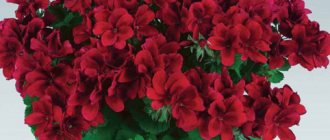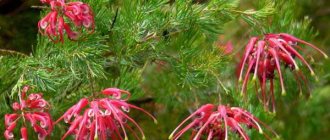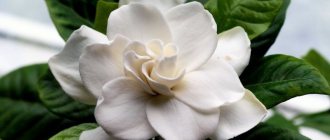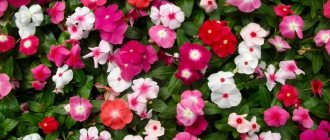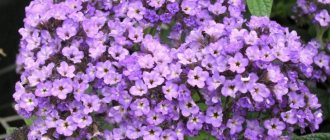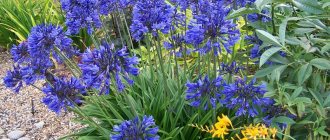Irezine is a flower with a difficult character and high demands, capricious and unpredictable. It is hardly worth recommending its cultivation to novice amateurs, except as an experiment, for the possible negative result of which you need to be mentally prepared in advance. But for experienced indoor plant lovers, caring for irezine can be a good tool for learning. And, if everything works out, the opportunity to add an interesting new item to your home collection, which will probably not remain in it as an extra.
Botanical description
80 species of plants from the genus Iresine (Latin Iresine) belong to the Amaranth family. In nature, plants are distributed throughout the continent of America and Australia, Galappagos and the Antilles. Irezine are herbaceous plants, shrubs and trees with climbing branches. The leaves are arranged oppositely, have an elliptical or rounded shape, sometimes broadly lanceolate; with fine teeth along the smooth edge of the sheet. The capitate inflorescence looks like a spike. In indoor floriculture, they mainly grow Herbst iresina and Linden iresina, which are valued for the color of their leaves. Often used when planting ridges or to decorate lawns along borders.
Is it possible to keep mother-in-law's tongue at home?
Let's figure out whether it is possible to keep a pike tail in an apartment, and also consider the positive and negative qualities of the plant.
Benefits and harms for the home:
- In the East, it is believed that mother-in-law’s tongue has a beneficial effect on the energy of the apartment.
- It has been scientifically proven that the juice of the plant has healing effects. It helps to disinfect and heal small wounds.
- According to some reports, pike tail can cure severe migraines, relieve fatigue and suppress attacks of aggression.
- The owners note that if you spend about half an hour in a room with a pike tail, your mood improves and you feel a surge of vigor and positivity.
- Almost all negative reviews are associated with unconfirmed superstitions and signs. Therefore they have no basis.
It turns out that there are no real reasons for the “harmfulness” of the plant. Therefore, if a person does not believe in omens, he can grow an unusual succulent at home without any problems.
Briefly about cultivation
- Flowering: the plant is grown as an ornamental foliage plant and rarely blooms in indoor cultivation.
- Lighting: bright light with shading in the afternoon.
- Temperature: in spring and summer – from 15 to 25 ºC, in autumn and winter – from 15 to 20 ºC, but not lower than 12 ºC.
- Watering: as the top layer of the substrate dries: in spring and summer - more often, in autumn and winter - less often. At temperatures below 16 ºC, the plant is watered symbolically.
- Humidity: normal for residential premises. In hot weather, you can spray the plant with warm water.
- Feeding: in spring and summer – 4 times a month with complex mineral or organic fertilizer. In the fall, fertilizing is gradually reduced, and in winter it is applied once every three weeks in the form of a solution in half the dosage.
- Dormant period: not clearly defined, but in winter growth and development slow down.
- Transplantation: when grown in a perennial crop - once every 2-3 years.
- Substrate: 4 parts of deciduous soil, 2 parts of humus soil and 1 part each of sand and peat.
- Reproduction: by cuttings.
- Pests: aphids, spider mites, whiteflies.
- Diseases: as a result of violation of maintenance conditions and improper care, the leaves of the plant may fall and shoots may stretch.
Read more about growing irezine below.
Lighting
Irezina is a light-loving plant. But it must be protected from direct sunlight. In the winter garden, bushes are placed in an area of diffused light or near a lamp.
Optimal daylight hours are from 14 to 20 hours. The flower is gradually accustomed to the sun. You can’t immediately expose it for a long time; the upper leaves will lose their shine and begin to dry out.
Caring for irezine at home
Lighting
The optimal location is for windows in all orientations except north. The irezine plant at home loves bright light, but on southern windows it is necessary to create diffused lighting during the hottest hours so that burns do not appear on the leaves of the plant. The plant should get used to direct rays little by little. When grown under fluorescent lamps, indoor irezine needs to be illuminated with them for at least 14 hours a day.
Temperature
For irezine, temperature does not play a special role. In summer, the plant feels good at temperatures from 15 to 25 °C, and in winter - from 15 to 20 °C. If the winter temperature drops below 12 °C, the plant may begin to rot, shed its leaves and die. And vice versa - too high a summer temperature will most likely lead to a loss of turgor in the leaves.
Watering irezine
Use soft water for watering irezine indoors and let it sit for at least a day before watering. If the tap water is too hard, it is better (if possible) to water with rainwater. In spring and autumn, the plant is watered as soon as the top layer of soil dries. In winter, watering is reduced, but in no case is it allowed to completely dry out the earthen clod. A lack, in fact, like an excess of moisture in the substrate, has a negative effect on plant growth. If the temperature in winter drops below 16 °C, then watering is reduced even more.
- Tuberous begonia: planting
Spraying
It would not be a bad idea to occasionally spray your homemade irezine, although the plant can tolerate dry indoor air.
Top dressing
From spring to early autumn, the irezine flower should be fed 4 times a month with mineral or organic fertilizers. In winter, fertilize a little more than once a month, and the solution itself is diluted twice.
Trimming
For more luxuriant growth of plants, they must be pinched annually - it is better to pinch out the apical shoots. In February, the plant can be pruned more seriously - this will stimulate the plant to grow in the spring.
Transplantation of irezine
If you grow a plant for one year, you don’t need to replant it. If indoor irezine is grown as a perennial plant, then at least once every two to three years it needs to be replanted in a slightly acidic substrate: 1 part peat and sand, 4 parts deciduous and turf soil and 2 parts humus. A prerequisite is high-quality drainage from expanded clay or broken bricks at the bottom of the pot.
Propagation of irezine by cuttings
From late winter to mid-spring, cuttings are taken from the mother plants, which are planted in the sand. For successful cuttings, the temperature must be kept at 17-20 °C, then the cuttings of the irezine flower will take root within a week and a half. After the roots appear, the cuttings are planted in individual pots in a substrate of 2 parts leaf, turf and humus soil (2 parts each) and 1 part sand. The temperature should be maintained at 19-21 °C. Young plants are usually used for cuttings, because they have not yet lost their decorative features.
How does it reproduce
Fatsia flower: home care and methods of propagation
At home, irezine can be propagated by seeds and cuttings. The first method is rarely used due to its complexity. It is usually used by breeders to develop new varieties of crops. The peculiarity of seed propagation is that new plants may not display some maternal traits.
The easiest way to propagate irezine is to cut off the tops and plant them in pots
Germination of seeds
Seed material is purchased at a flower shop. It is wrapped in gauze, which is moistened with water daily. When the seeds hatch, they are sown in a box filled with peat. They are buried 0.5 cm, and the container is covered with film or glass.
Caring for crops involves watering and ventilating the mini-greenhouse. When seedlings appear, the cover is removed. When 3-4 leaves appear, the plants are transplanted into small containers. Young bushes are kept in the same conditions as adult flowers.
Rooting cuttings
In spring, bushes are rejuvenated by cutting cuttings. Instead of throwing away the branches, you can root them and grow new flowers. The rooting procedure is carried out as follows:
- Cut cuttings about 10 cm long.
- Remove the lower leaves.
- The sections are dusted with growth enhancer powder.
- Planted in boxes filled with wet sand.
- Cover with film so that the cover does not touch the cuttings.
Every day the film needs to be opened, wiped from condensation, and the plantings must be ventilated. A signal that the cuttings have taken root will be the appearance of roots and young shoots. After this, the plants are transplanted into separate pots.
Some gardeners, after cutting, first place the cuttings in a glass of water and only after the roots appear, plant them in containers.
Note! The film and the walls of the box must be wiped from condensation, otherwise the seedlings may become infected with fungus due to excessive humidity levels.
Diseases and pests of irezine
Irezine is shedding its leaves. The stems of young plants become bare if the shoots are pruned at the wrong time or if there is insufficient lighting. In adult specimens, bare stems are a natural phenomenon.
- Citrus plants from seeds, types of citrus fruits
Irezine shoots stretch if the plant does not have enough light.
The leaves of the irezine are falling. In summer, the plant can shed its leaves if there is insufficient watering, as well as with excessive soil moisture. Watering should be regular.
Pests of irezine. The main dangers are aphids, spider mites and whiteflies.
What does it mean if Sansevieria blooms?
Signs associated with flowering can have a positive or negative meaning. This is a rather rare phenomenon and its interpretation depends on the time of year and duration.
If the sansevieria bloomed:
- Flowering during cold weather is always unexpected and promises the owner big changes. Usually these are troubles at work, major family quarrels, forced moves and separation from loved ones.
- If buds form in summer or spring , the owners will experience good luck, prosperity and positive changes in life.
- If the buds begin to wither before they have time to open, this is a bad sign. This phenomenon indicates that the owner has envious people and ill-wishers.
Blooming piketail is a fairly rare occurrence. Experts consider this a sign of higher powers and a signal to action. The flower warns owners about impending changes and pushes them to solve problems.
Kinds
Iresine Lindenii / Iresine lindenii
The habitat of this herbaceous perennial is the rain forests of tropical Ecuador. The dark red stem reaches a height of just over half a meter. The dark red leaves are covered with thin veins of bright crimson color; oval-lanceolate in shape, grow up to 6 cm in length. After pruning the plant, the trunk begins to branch, sending out young shoots with leaves - quite quickly you can get a red-crimson blanket of leaves near the house.
Iresine Herbstii / Iresine herbstii
This herbaceous perennial grows naturally in the humid forests of tropical Brazil. The shoots are red in color and reach a height of up to 40 cm. The leaves are rounded, in the upper part they are shaped like hearts; dark purple in color with veins of a bright red hue. The variety aureoreticulata has red shoots and leaf petioles; The leaves are green, the veins are golden and red. The wallisi variety is distinguished by its small leaves and strong bushiness with a low plant height; leaves are red-metallic in color.
Signs and superstitions for the home associated with Sansevieria
It is generally accepted that snake skin can filter out negativity and protect household members from envious people and the evil eye. Therefore, the flower is recommended to be grown by public figures, people working in large teams, as well as social workers.
By the appearance of the plant, you can determine the attitude of others, the well-being within the family or team. And also recognize future troubles and troubles.
Bad
There are many negative signs and superstitions associated with sansevieria. By the way, the name “mother-in-law’s tongue” is used only in Russia. It is believed that a plant given by the bride's mother will lead to quarrels, scandals and an early separation of the couple.
Also read: Is it possible to keep Decembrist at home: signs and superstitions
Bad omens:
- If the snake skin begins to dry out, wither and eventually die, this is a very bad sign. Troubles, misfortunes and losses await the owner.
- The pike tail dies in the house of an unhappy person, in a house where people do not like each other, as well as in rooms with negative energy.
- Mother-in-law’s tongue cannot be kept in the apartment where the newlyweds live. According to popular belief, the plant disrupts the harmony within a fragile family, provokes quarrels out of nowhere and scandals.
- If the leaves turn yellow and fade, then the owner will soon be separated from a relative or loved one.
- The flower dries and withers if someone is jealous of the family or is planning something evil.
- The pot should not be placed near the head of the sleeping person. The flower will draw positive energy from a person. As a result, he will become angry, irritable and aggressive.
Mother-in-law's tongue cannot be accepted as a gift or purchased for memorable and important dates. If a flower appears in the house on the New Year, the birth of a child, an anniversary or a wedding anniversary, then the owners will face failures, quarrels and problems in their personal lives.
If your succulent is drying out, fading, rotting or wilting, be sure to read the article on proper care of Sansevieria.
Good
According to popular belief, the pike tail flower is considered a family talisman. And if the owners “forgot” the sansevieria in the new house, then it is not advisable to throw it away. A houseplant will continue to protect the house from negative energy and troubles. To strengthen the connection with the pike tail, you need to transplant it into a new, beautiful pot and take good care of it.
What are the benefits of a pike tail, positive signs:
- The flower protects household members from envy, damage, negativity, and the evil eye.
- The shape of the leaves can determine the situation in the family. Short and slightly rounded leaves promise harmony in relationships and love. And long and pointed leaves promise profit and stability.
- Saving a dying plant means good news, positive changes, and recovery for the patient.
- In the home of a strong married couple, the plant enhances affection, mutual understanding and trust.
- A purchased or gifted plant takes longer to adapt to the new background. But a flower grown from a seed or a small shoot will be saturated with the energy of the apartment and will tune in to the owners. Fine settings will help the pike tail better protect household members from problems and troubles.
- According to the signs and observations of its owners, the pike tail relieves fatigue, clears the mind of negative emotions, calms and puts people in a positive mood.
- The flower is able to get rid of apathy and laziness, cleanse the energy of the apartment and relieve tension after communicating with unpleasant people.
If you place a pot with a plant near the workplace, it will protect the owner from minor troubles, protect him from nagging superiors and unpleasant conversations with colleagues.
Reproduction
The plant can be propagated by two methods: vegetative (cuttings) and seeds.
Cuttings
Cuttings are usually carried out from late February to April.
Before carrying out the procedure, it is necessary to prepare the substrate in the form of sand, pouring it into a small container. Part of the stem must be cut with a knife and placed in the sand. The container with the cutting is placed in a place where the constant temperature is +17...+20°C. In such conditions, roots will appear in 1–1.5 weeks.
The rooted cutting is moved to a new pot filled with soil. It should be prepared by first mixing humus, turf and leaf soil in equal proportions and adding a little sand. Then the usual care is continued.
Important! Seedlings that have just been planted in the soil need a temperature of +19°...+21°C until they are fully adapted. Otherwise the care is normal
Seeds
Sowing irezine seeds is less common, but this method can also be used to grow the plant:
- First you need to purchase seed and substrate from a specialized store.
- Next, you need to plant the seeds in a container filled with soil.
- The container should be covered with a transparent material - glass or polyethylene.
- Until the first shoots appear, the crops are moistened with water at room temperature from a spray bottle as the substrate dries, and ventilated by removing the cover.
- Next, when the seedlings have already sprouted from the soil, the container must be opened and placed in a place well lit with bright, diffused light, where a stable temperature is maintained above room temperature. The sprouts also continue to be watered moderately.
- You need to plant the seedlings in the pot after 3 leaves appear. You then need to care for it like you would for ordinary bushes.
Varieties of Lycoris
Spider lily can be grown both as a garden plant in open ground and as a home plant. The growing temperature in the garden should be about 27, and in room conditions - about 20 degrees Celsius. The most popular are 4 subspecies of lyco rice: blood red, radiant, golden and scaly.
Lycoris radiata has a special, unusual beauty, which has narrow,
long petals and stamens 15 cm long are formed in the form of a spider.
It is interesting that in lycoris the dormant period is observed twice - not only in winter, but also in summer. During the summer months, the plant sheds its leaves and “sleeps” until August-September.
Alternanthera Forsk.
AMARANTHA FAMILY - AMANANTHACAE JUSS.
About 850 species of 65 genera of herbaceous plants and shrubs. In culture, representatives of 6 genera.
Genus Alternanthera - Alternanthera Forsk.
The name apparently comes from the Latin word alternans - “changeable” and is explained by the polymorphism of many species. The genus contains approximately 200 species of annual and perennial herbaceous and semi-shrub plants from tropical and subtropical regions of America, some from the Galapagos Islands, Africa, Asia, Australia. Read more about Alternanthera - Alternanthera Forsk. ...
Plant characteristics
| Genus | Irezine |
| Family | Amaranthaceae |
| Motherland | America, Brazil |
| Escape type | Straight, branching |
| Inflorescence | Spica-shaped |
| Petal color | White, cream and others |
| Leaf structure and color | Obovate, heart-shaped, oval, with a pointed end |
| Flowering period | All year round |
| Fetus | Round box with seeds |
| Reproduction | Seeds, cuttings |
The Irezine genus includes shrubs, subshrubs and trees with rapid growth rates, differing in such characteristics as: bush height, shape and color of foliage, size of inflorescences and their shades.
The leaves are alternate or oppositely arranged, can be round, oval or broadly oval, entire or with denticles along the edges. Their shades are very diverse. There are species with green, purple, violet foliage. Some varieties have a pattern of veins on the leaf blades in the form of a mesh or arcuate stripes.
The inflorescence is spike-shaped. The flowers are small, inconspicuous, five-petaled, white, cream, purple or yellow.
After flowering, round or slightly elongated fruits with red or brown seeds appear on the bush.
What an indoor irezine flower looks like can be seen in the photo below, where you can see all its characteristic differences:

